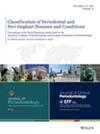Titanium migration and bone response in loaded osseointegrated implants: ESEM-EDX analysis in Macaca fascicularis.
IF 3.8
2区 医学
Q1 DENTISTRY, ORAL SURGERY & MEDICINE
引用次数: 0
Abstract
BACKGROUND Titanium nanoparticle (TP) migration into peri-implant bone may influence osseointegration. It remains unclear how loading protocols may affect TP distribution. This study aimed to detect TP in the bone around implants undergoing different loading protocols in Macaca fascicularis. METHODS Nine histological samples containing 21 implants with two loading groups were analyzed. In the delayed-loaded (DL) group (n = 16), the implants were loaded after 3 months and retrieved after 3 months, and in the immediately loaded (IL) group (n = 5), they were loaded on the day of surgery and retrieved after 3 months. Environmental scanning electron microscopy (ESEM) grayscale-level detection and energy-dispersive X-ray spectroscopy (EDX) microchemical analysis were used to assess TP and bone mineralization. Regions of interest (ROI) located at the implant coronal/apical portion (100×) and at the bone-implant interface (1000×) were selected. Bone area distribution (mean% ± SD%) and titanium content were analyzed using two-way analysis of variance (ANOVA) (p < 0.05). RESULTS Titanium granules (2-10 µm) were detected in all regions, with a higher prevalence in the coronal portions of DL implants. In IL implant sections, bone closer to the implants showed a lower prevalence of titanium (p < 0.05). EDX analysis demonstrated a decreasing trend in titanium from the nearest areas to those more distant (up to 2.0 mm). DL implants exhibited lower percentages of mineralized bone compared to IL implants in the coronal portion (mean values 31.0 ± 13.7 and 11.6 ± 2.8) (p < 0.05). IL implants showed a higher percentage of mineralized bone (p < 0.05) in the apical region (mean values 51.8 ± 15.5 and 32.2 ± 15.6). CONCLUSION TP were widely present in bone tissues adjacent to the implant surface, particularly at the coronal bone. In the coronal portion of the DL group, a less mineralized bone area was observed compared to the IL group, suggesting higher bone remodeling activities. PLAIN LANGUAGE SUMMARY Titanium particles were widely present in bone tissues adjacent to the implant areas, with greater distribution observed in regions experiencing significant wear (i.e., the coronal portion of the cortical bone), likely due to surgical insertion and related procedures.负载骨整合种植体中钛迁移和骨反应:束状猕猴的ESEM-EDX分析。
钛纳米颗粒(TP)向种植体周围骨的迁移可能影响骨整合。目前还不清楚加载协议如何影响TP分发。本研究旨在检测不同加载方式下猕猴束状体植入物周围骨的TP含量。方法对21个种植体的组织学标本进行分析。延迟加载(DL)组(n = 16)在3个月后加载,3个月后取出种植体;立即加载(IL)组(n = 5)在手术当天加载,3个月后取出种植体。采用环境扫描电子显微镜(ESEM)灰度级检测和能量色散x射线光谱(EDX)微化学分析评估TP和骨矿化。选择位于种植体冠状/根尖部分(100×)和骨-种植体界面(1000×)的感兴趣区域(ROI)。骨面积分布(mean%±SD%)和钛含量采用双因素方差分析(ANOVA) (p < 0.05)。结果所有区域均检测到2 ~ 10µm的钛颗粒,其中冠状区含量较高。在IL种植体切片中,靠近种植体的骨钛含量较低(p < 0.05)。EDX分析表明,从最近的区域到更远的区域(高达2.0 mm),钛的含量呈下降趋势。与IL种植体相比,DL种植体冠状部分矿化骨的百分比较低(平均值为31.0±13.7和11.6±2.8)(p < 0.05)。IL种植体在根尖区矿化骨比例较高(平均值分别为51.8±15.5和32.2±15.6)(p < 0.05)。结论tp广泛存在于种植体表面附近的骨组织中,尤其是冠状骨。在DL组的冠状部分,与IL组相比,观察到更少的矿化骨区域,表明更高的骨重塑活动。钛颗粒广泛存在于种植体区域附近的骨组织中,在经历明显磨损的区域(即皮质骨的冠状部分)观察到更大的分布,可能是由于手术插入和相关手术。
本文章由计算机程序翻译,如有差异,请以英文原文为准。
求助全文
约1分钟内获得全文
求助全文
来源期刊

Journal of periodontology
医学-牙科与口腔外科
CiteScore
9.10
自引率
7.00%
发文量
290
审稿时长
3-8 weeks
期刊介绍:
The Journal of Periodontology publishes articles relevant to the science and practice of periodontics and related areas.
 求助内容:
求助内容: 应助结果提醒方式:
应助结果提醒方式:


